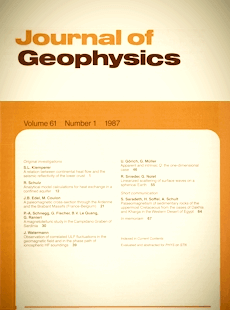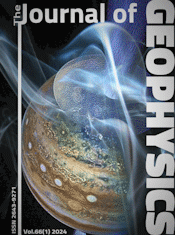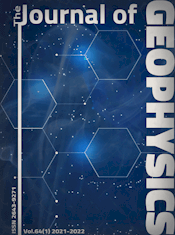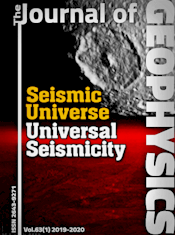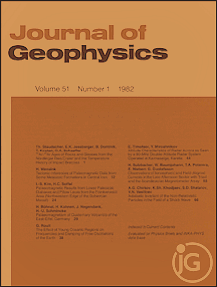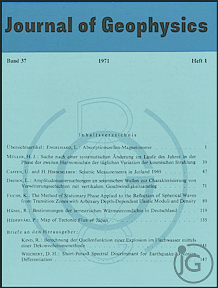Statistical investigations on diurnal and annual periodicity and on tidal triggering of local earthquakes in Central Europe
Article Sidebar
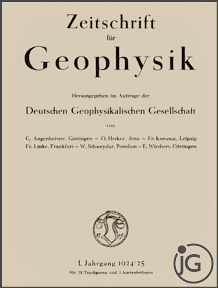
Vols. 1-18 (1924-1944), ISSN 0044-2801
Main Article Content
Abstract
Two regional earthquake catalogues are analysed in order to investigate the existence of diurnal, annual and Earth-tide related periodicities of the occurrence time of seismic events. The first earthquake catalogue covers the total region of the Federal Republic of Germany for the time period 1021-1979 (1530 events) and is investigated with respect to the existence of diurnal and annual periodicities. With the help of the graphical representation for Schuster's test, a midnight and a midday maximum are separated for different intensity classes. A winter maximum present in the data prior to 1930 is absent in the more recent data. It is argued that both diurnal and annual maxima are artifacts due to data sampling problems. The second earthquake catalogue refers to the western part of Germany (Lower Rhine Graben, Rhenish Massif) and the time period 1979-1984 (1012 events of magnitude ML = 0.0–5.1). For the events of this catalogue, a tidal phase is computed according to a model for the triggering of the predominant dip-slip earthquakes. The distribution of phases supports the triggering hypothesis (at the 99% significance level if Schuster's test is applied).
 ARK: https://n2t.net/ark:/88439/y094877
ARK: https://n2t.net/ark:/88439/y094877
Permalink: https://geophysicsjournal.com/article/94
Article Details
References
Ahorner, L. (1983b) Historical seismicity and present day micro-earthquake activity of the Rhenish Massif, Central Europe. In: Fuchs, K. (Ed.) Plateau Uplift, pp. 198-221. Springer, Berlin
Ahorner, L., Baier, B., Bonjer, K.-P. (1983) General pattern ofseismotectonic dislocation and the earthquake-generating stress field in Central Europe between the Alps and the North Sea. In: Fuchs, K. (Ed.) Plateau Uplift, pp. 187-197. Springer, Berlin
Chapman, S., Bartels, J. (1951) Geomagnetism, Vol. 2. Clarendon Press, Oxford
Davison, C. (1938) Studies on the periodicity of earthquakes. Murby, London
Heaton, T.H. (1975) Tidal triggering of earthquakes. Geophys. J. R. Astron. Soc. 43:307-326
Heaton, T.H. (1982) Tidal triggering of earthquakes. Bull. Seism. Soc. Am. 72:2181-2200
Karnik, V. (1971) Seismicity of the European Area. Reidel, Dordrecht
Klein, F.W. (1976) Earthquake swarms and the semidiurnal earth tide. Geophys. J.R. Astron. Soc. 45:245-295
Leydecker, G. (1986) Erdbebenkatalog fur die Bundesrepublik Deutschland mit Randgebieten fur die Jahre 1000 bis 1981. Geologisches Jahrbuch Reihe E 36, Hannover
McClellan, P.H. (1984) Earthquake seasonality before the 1906 San Francisco earthquake. Nature 307:153-156
Melchior, P. (1978) The tides of the planet earth. Pergamon Press, Oxford
Schneider, G. (1975) Erdbeben. Enke, Stuttgart
Schuster, A. (1897) On lunar and solar periodicities of earthquakes. Proc. Roy. Soc. 61:455-465
Shimshoni, M. (1971) Evidence for higher seismic activity during the night. Geophys. J. R. Astron. Soc. 24:97-99
Shlien, S. (1972) Earthquake-tide correlation. Geophys. J. R. Astron. Soc. 28:27-34
Souriau, M., Souriau, A., Gagnepain, J. (1982) Modeling and detecting interactions between earth tides and earthquakes with application to an aftershock sequence in the Pyrenees. Bull. Seism. Soc. Am. 72:165-180
Tams, E. (1926) Die Frage der Periodizitiit von Erdbeben. Borntraeger, Berlin
Ulbrich, U. (1985) Statistische Untersuchungen der Erdbebentiitigkeit auf dem Gebiet der Bundesrepublik Deutschland im Hinblick auf Periodizitiiten und mogliche Triggermechanismen. Diploma thesis, Institut fur Geophysik und Meteorologie Koln
Wilmes, H. (1983) Entwicklung eines horizontalen Stabextensometers mit hydrostatischer Lagerung zur Messung lokaler Gezeitendeformationen in der Lithosphiire. Miinchen: Dtsch. Geodiit. Komm., Reihe C Heft 281
Young, D., Zurn, W. (1979) Tidal triggering of earthquakes in the Swabian Jura. J. Geophys. 45:171-182


